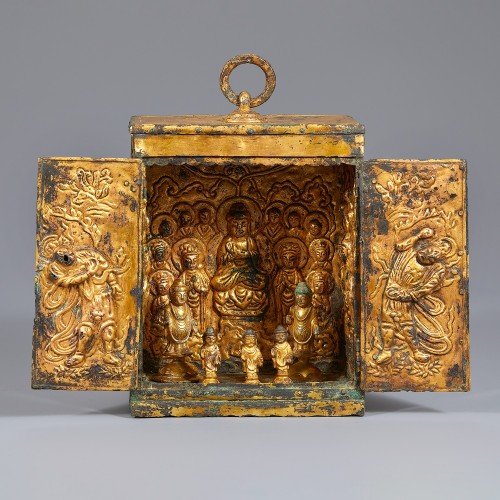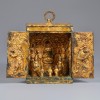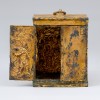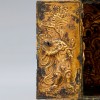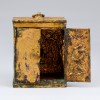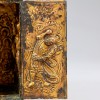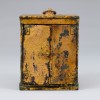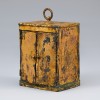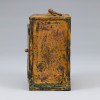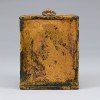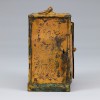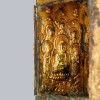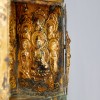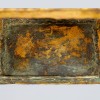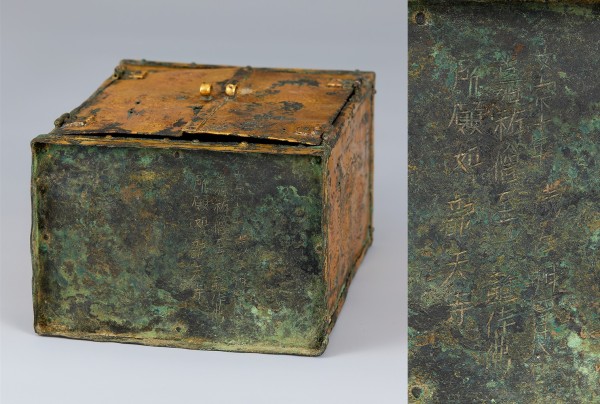본문
이 유물은 고려시대에 제작된 금동제 상자형 불감으로, 희소한 상자형 구조에 정교한 조형성을 갖춘 유물입니다. 불감(佛龕)은 불상이나 경전을 봉안하여 예불에 사용하는 이동식 법당입니다. 삼국시대 이후 불교 신앙 실천의 도구로 널리 제작되었습니다.
지붕이 없는 직육면체 구조에 휴대를 위한 금속제 고리가 부착되어 있고, 고리 표면에도 장식 문양이 새겨져 있어 세밀한 조형 감각을 보여줍니다. 좌우 문은 여닫이식 구조이며 잠금장치를 걸 수 있는 고리 형태의 철물이 있습니다.
문을 열면 중앙에는 연화좌(蓮華座)에 앉아 설법인(說法印)을 취한 본존불(本尊佛)이 위치하고, 좌우로 보살과 제자들이 위계에 따라 배치되어 있습니다. 내부 양측 벽면에도 유사한 도상이 반복되며, 모두 부조(浮彫) 기법으로 조각되어 입체감이 두드러집니다. 천장에는 삼조룡(三爪龍), 문의 내면에는 인왕상(仁王像)이 각각 조각되어 있으며 이들 역시 부조로 표현되어 불법의 신성성과 수호적 의미를 강조합니다.
외부 좌우 측면에는 갑주(甲胄)를 갖춘 사천왕이, 뒷면에는 중심불(中心佛)을 둘러싼 설법도(說法圖)가 음각되어 있습니다. 이는 단순한 신앙 대상을 보여주는 데에 그치지 않고 교화의 기능까지 표현했음을 알 수 있습니다.
내부와 외부를 포함해 총 12면에 장식이 있으며, 전체적으로 종교적 장엄함과 세밀한 조형미가 조화를 이루어 고려시대 불교공예의 수준을 잘 보여줍니다.
바닥에 음각된 명문을 통해 이 불감의 봉안 시기와 제작 의도, 제작 장소를 확인할 수 있습니다. 또한 이를 통해 불교 신앙의 지속성과 전승 양상까지 파악할 수 있습니다.
文宗十年歲在阴四月八日 (문종십년세재음사월팔일)
嘉祐僧至□諸寺佛 (가우승지□제사불)
所願如龍天寺 (소원여용천사)
“고려 문종 10년(1056) 음력 4월 8일(초파일).
가우(북송 인종 때의 연호(1056~1063)) 연간의 승려가 부처께 예를 올리다.
용천사에서 염원하였다.”
*사진 속 불상은 삼국시대 유물로, 원래 불감(佛龕)과 함께 출토된 불상이 유실됨에 따라 전시를 위한 대체 구성물로 배치된 것입니다.
━━━━━
此为高丽时期的铜鎏金箱形佛龛,稀有箱形结构,造型精巧。佛龛是供奉佛像或经典、用于礼佛的可携带式小型佛堂,自三国时代以来作为佛教信仰实践的器具而制作广泛。
呈无顶的长方体结构,配有便于携带的金属环,环的表面也刻有装饰纹样,造型细腻。左右两扇门为对开式结构,并带有可挂锁的环形金属件。
打开门后,中间安置着结跏趺坐于莲华座上、结“说法印”的本尊佛,两侧则按尊卑次序排列着菩萨与弟子。内部两侧壁面也重复着类似的图像,皆以浮雕技法雕刻,立体感十分突出。天花板上雕有三爪龙,门内侧则雕有仁王像,同样以浮雕手法表现,强调了佛法的神圣性与守护意义。
外部左右两侧雕刻有身披甲胄的四天王,背面则刻有环绕中心佛的说法图。这不仅仅是单纯的信仰对象,也体现了佛教的教化功能。
内外共有十二面装饰,整体上宗教的庄严感与精致的造型美相互协调,充分展现了高丽时期佛教工艺的高度水平。
在底部的阴刻铭文中,可以确认此佛龛的奉安年代、制作意图与制作地点,并由此了解佛教信仰的延续与传承情况。
铭文内容如下:
文宗十年岁在阴四月八日
嘉祐僧至□诸寺佛
所愿如龙天寺
释义:
“高丽文宗十年(1056年)阴历四月八日(佛诞日)。嘉祐年间(1056~1063年)的僧侣礼拜诸佛,于龙天寺发愿。”
* 照片中的佛像为三国时代文物。由于原本与佛龛同时出土的佛像已遗失,现展出的佛像是为展示效果而进行摆放。
━━━━━
This is a gilt-bronze, box-shaped Buddhist reliquary from the Goryeo Dynasty, notable for its rare form and fine craftsmanship. A bulgam is a portable shrine used to enshrine a Buddha image or scriptures for worship. These were widely made after the Three Kingdoms period as tools for Buddhist devotion.
It is a rectangular box without a roof, fitted with a metal loop for portability. The loop is also engraved with decorative patterns, showing the artisan’s attention to detail. The doors on either side are hinged and fitted with metal fasteners for locking.
When opened, the central compartment features the principal Buddha seated on a lotus pedestal, forming a dharmachakra mudra (gesture of teaching). Flanking the Buddha are bodhisattvas and disciples, arranged hierarchically. Similar imagery is repeated on the interior side walls, all rendered in high-relief carving, giving them a strong three-dimensional quality.
On the ceiling is a carving of a three-clawed dragon, while the inside of the doors features guardian kings, also in relief, emphasizing the sanctity and protective nature of Buddhist law.
The exterior sides feature armored Four Heavenly Kings, and the back panel is engraved with a scene of the Buddha delivering a sermon, surrounded by figures—illustrating that the object served not only as an icon of worship but also as a tool for spiritual instruction.
In total, there are 12 decorated surfaces, harmonizing religious grandeur with delicate artistry—an excellent example of Buddhist craftsmanship from the Goryeo period.
The inscription engraved on the base reveals the date, purpose, and location of the reliquary's enshrinement, offering insight into the continuity and transmission of Buddhist faith.
Inscription:
文宗十年歲在阴四月八日
嘉祐僧至□諸寺佛
所願如龍天寺
Translation:
"On the 8th day of the 4th lunar month in the 10th year of King Munjong of Goryeo (1056).
During the Jiayou era (1056–1063) of Emperor Renzong of Northern Song,
a monk offered reverence to the Buddha at Yongcheonsa Temple."
* The Buddha figure shown in the photo is from the Three Kingdoms period and was placed here for exhibition purposes, as the original Buddha figure that was housed in the bulgam has been lost.
